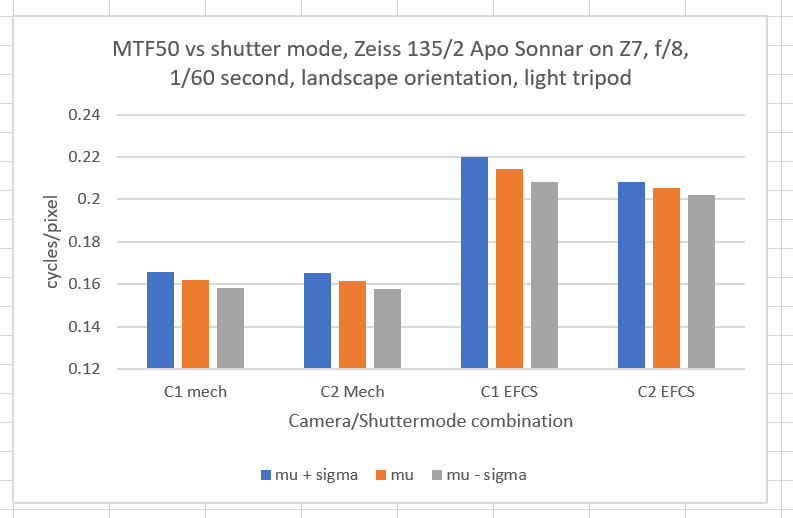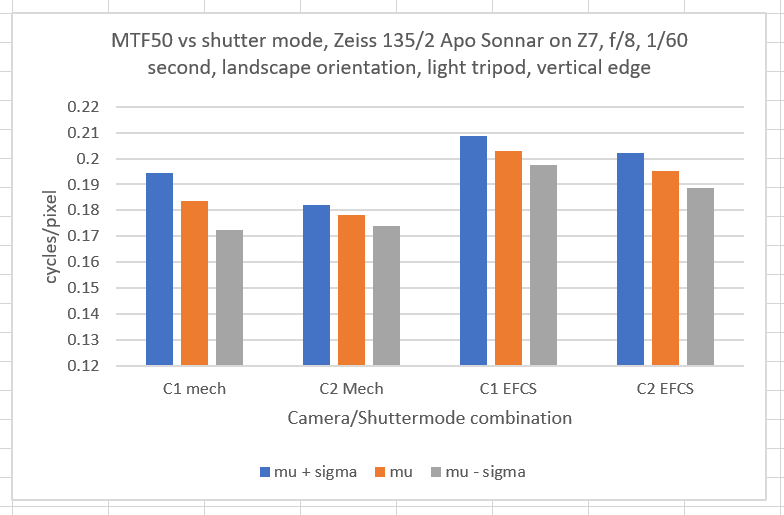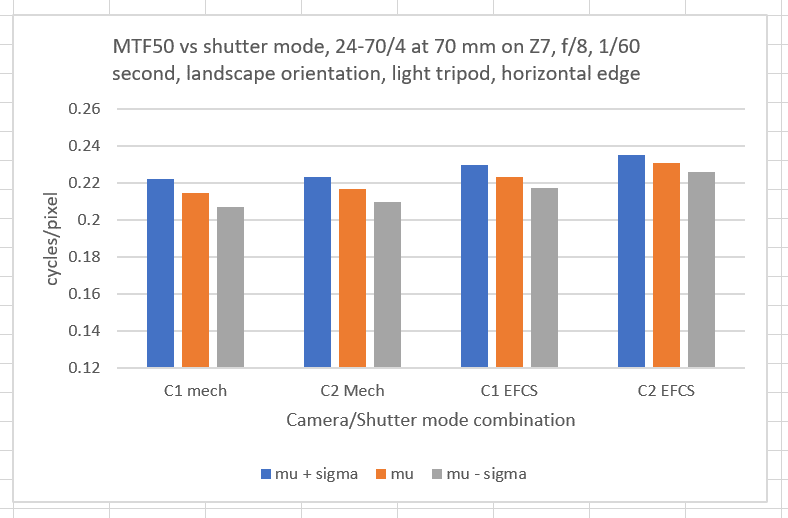This is one in a series of posts on the Nikon Z7. You should be able to find all the posts about that camera in the Category List on the right sidebar, below the Articles widget. There’s a drop-down menu there that you can use to get to all the posts in this series; just look for “Nikon Z6/7”.
When I posted the Z7 shutter shock results a few days ago, someone claimed that shutter shock was highly sample dependent. I’d noticed nothing of the short when I was testing a7RIIs, but today I got hold of another Z7 and decided to measure both.
The protocol:
- Slanted edge target
- Lossless compressed raw
- ISO 400
- Zeiss 135 mm f/2 Apo-Sonnar ZF.2 attached via FTN adapter
- Focus wide open, then stop down to f/8 (this is not a recipe for the sharpest image, but for the most repeatable from camera to camera)
- EFCS and fully mechanical shutter, 32 exposures for each for each camera
- 3 seconds between exposures, using the camera’s internal intervalometer
- Files demosaiced in dcraw
- Luminance MTF50 of horizontal edge calculated in Imatest.
The results:
C1 is the original Z7, which has a serial number that indicates that it is about the 2,000th camera produced. The new camera is identified as C2; its serial number is about 9000 after then first one. The averageMTF50 values — MTF50 is a good proxy for sharpness– (aka mu values), and the average plus one standard deviation (mu + sigma) and the average minus one standard deviation (mu – sigma) values are plotted in groups.
You can see that I didn’t focus both sets of images quite the same way, since the camera 1 EFCS results are better. You can also see that the shutter shock is sufficiently strong than the blur introduced by the shock is far greater than that caused by the misfocusing, and both cameras produce essentially the same results for the fully mechanical shutter.
Now let’s look at a vertical edge:
Since the camera’s shutter operates mostly in the up/down direction, it doesn’t affect vertical edges as much as horizontal ones, even though the tripod is stiffer vertically than horizontally.
I ran a similar test with the Z7-native 24-70 mm f/4 Nikkor S at 70 mm. In order to get rid of the dependence of the results on initial manual focusing accuracy, I set the camera to AF-S with the pinpoint spot. I used an external intervalometer to trigger the series of shots since the internal one doesn’t let you see the visual verification of focus acquisition. The mounting arrangments were different, too. With the Zeiss 135, I clipped the camera in via the 1/4-20 filling on the bottom of the FTZ mount. With the 24-70, I used the mount on the base of the camera. This is better for stability since the up/down forcing function from the camera is now located more squarely over the center of the tripod.
Because of the combination of the different mounting arrangement and the shorter focal length of the lens, shutter shock is much less of a problem here. Both cameras perform substantially the same, though.
Although a sample space of two is not statistically significant here, this reinforces two conclusions that I’ve come to:
- Shutter shock with MILCs is not highly dependent on sample variation
- At 70 mm and under (and probably at 85 mm and under) shutter shock from the Z7 mechanical shutter is not much of an issue.



Clearly the sample variance is mainly in the things around the camera: the operator and tripods.
Man, seeing all this testing is making me awfully tempted to buy a new stiffer tripod and head…
Not wanting to be a bother but have you done the comparison with full electronic shutter on Z7 or any other camera? I’d presume there’s some mechanical shock related to releasing the shutter mechanism, but most likely too minor to matter. Never hurts to check, though.
https://blog.kasson.com/nikon-z6-7/shutter-shock-and-the-nikon-z7/
Somehow missed that – thanks!
Jim,
If you repeated all these static tests (heavy/light tripods, stands & heads; mechanical/EFCS) with a 3 second shutter delay, would all these variations disappear? If you have time to use a tripod, you also have time for a delayed shutter shot.
Thank you
(Great series)
That would be logical, but preliminary testing is not promising. I’ll do some more work.
But what’s the upside over EFCS even if it does work?
The upside would be that I would not have to worry about which shutter I’m using on any tripod. But I now realize this will never be: a mechanical shutter on a MILC inherently generates more vibes than even a DSLR mechanical shutter. My brain is still in DSLR mode, where I always use a 3″ delay + EFCS. My guess is that I could eliminate any delay by switching to a MILC with a remote.
Thanks again
Or just use EFCS and a 2-second self timer delay.